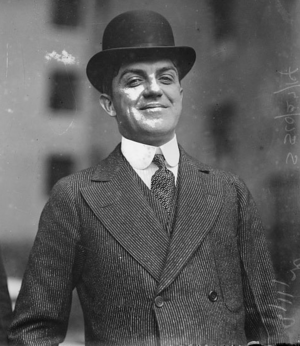Charles Weeghman facts for kids
Quick facts for kids
Charles Henry Weeghman
|
|
|---|---|

Weeghman in 1914
|
|
| Born | March 8, 1874 Richmond, Indiana, U.S.
|
| Died | November 1, 1938 (aged 64) Chicago, Illinois, U.S.
|
| Other names | Lucky Charlie Weeghman |
| Education | Richmond High School |
| Occupation | Restaurateur, Owner of the Chicago Whales and Chicago Cubs |
Charles Henry Weeghman (born March 8, 1874 – died November 1, 1938) was an American businessman. He was known for his restaurants and for owning baseball teams. He started opening quick-service lunch places in Chicago in 1901. Later, he helped start a new baseball league called the Federal League. He owned a team called the Chicago Whales. In 1914, he built a baseball stadium. This stadium is now famous as Wrigley Field.
After the Federal League ended, Weeghman bought a big part of the Chicago Cubs baseball team. He moved the Cubs to his new stadium, which was then called Weeghman Park. His restaurant business started to struggle because he spent a lot of time and money on baseball. Also, people started to prefer different kinds of restaurants. In 1919, he lost control of the Cubs to William Wrigley Jr.. Wrigley Jr. then changed the stadium's name. Charles Weeghman's later business ideas were not successful. Towards the end of his life, he worked as an assistant manager at a restaurant.
Who Was Charles Weeghman?

Charles Weeghman was born on March 8, 1874. His hometown was Richmond, Indiana. He went to Richmond High School there.
Weeghman started working as a waiter. He earned $10 a week. His boss quickly saw his talent and promoted him. Eventually, Charles opened his very own lunch counter in Chicago. His first restaurant opened on the same day his main competitor died. This helped his business grow.
His restaurants were unique. They only served cold sandwiches. Diners sat on special one-armed school chairs. This allowed Weeghman to fit more people inside. At one point, he owned fifteen of these diners. One of them, located at Madison and Dearborn, served about 35,000 people every day!
Weeghman and Baseball
Weeghman loved baseball. In 1911, he tried to buy the St. Louis Cardinals baseball team. The owner, Helene Hathaway Britton, had just inherited the team. She turned down his offer of $350,000. She later sold the team to someone else.
In 1913, Weeghman became a founder of the new Federal League. He owned the Chicago Whales team. He decided to build a brand new baseball park for them. This park was made of steel and concrete. It was called Weeghman Park. He rented the land for 99 years. The cost was $16,000 each year. He chose the spot because it was close to the 'L' train tracks.
In 1915, the Federal League and the older baseball leagues made a deal. This allowed Weeghman to buy a team from the older league. In 1916, he bought a major share of the Chicago Cubs. He paid $500,000 for the team. He then moved the Cubs from their old wooden stadium, West Side Park, to his modern Weeghman Park.
Weeghman spent a lot of money to get star players for the Cubs. In 1917, he paid $50,000 to get two great players, Grover Cleveland Alexander and Bill Killefer. He wanted to make the Cubs a winning team.
Losing the Cubs and Later Life
Over time, Weeghman's lunch counter business became less popular. He had to sell more and more of his shares in the Cubs team. He sold them to William Wrigley Jr., who owned a chewing gum company. This helped him get money.
In 1918, Weeghman stepped down as the president of the Cubs. By 1919, he had sold all his remaining shares to Wrigley. By 1920, he was no longer on the Cubs' board. The Wrigley family then owned the Cubs for the next sixty years. This also led to the stadium's name change. It went from Weeghman Park to Cubs Park, and then to Wrigley Field.
In 1920, his restaurant chain went bankrupt. His brother, Albert, took over the business. Charles Weeghman moved to Manhattan, New York City. He tried to start new restaurants there. Other baseball owners and friends helped him. But his new restaurants also failed. In the 1930s, two more of his restaurant ideas did not work out.
Charles Weeghman passed away on November 1, 1938. He died from a stroke in Chicago, Illinois. At the time of his death, he was working as an assistant manager at a restaurant in Fort Lee, New Jersey.
|

